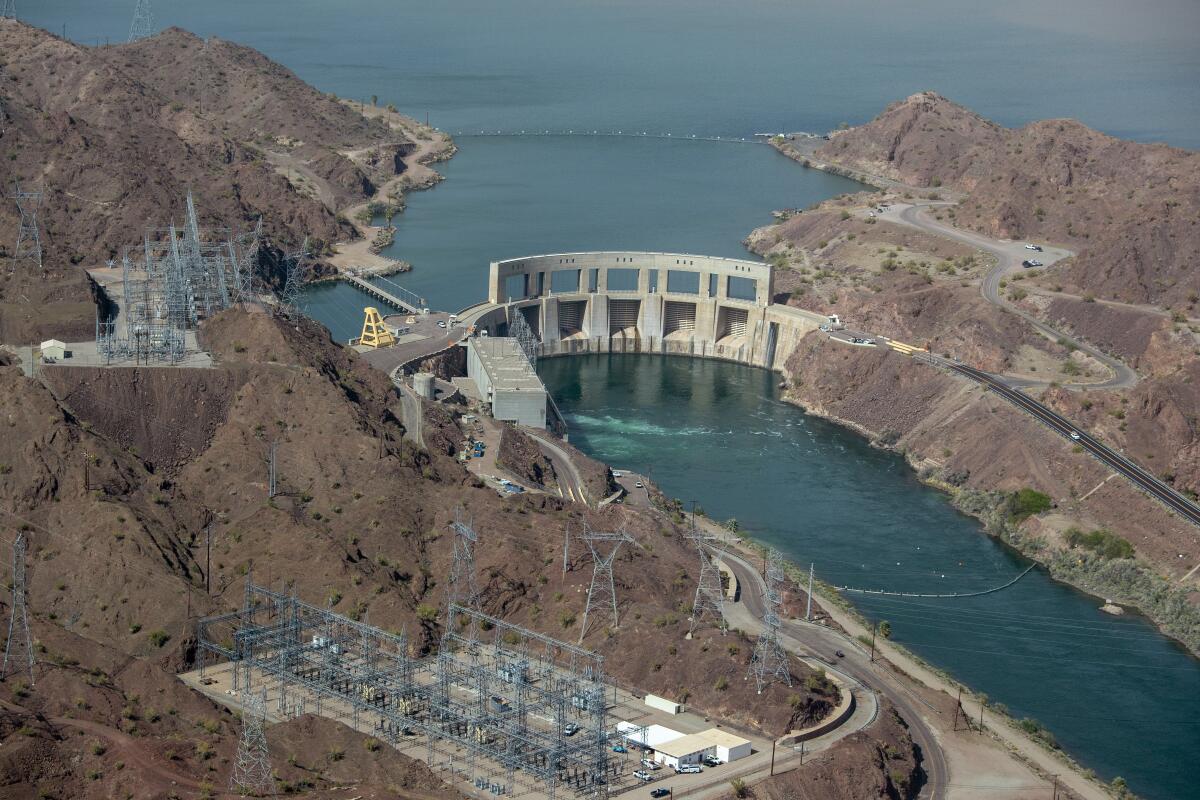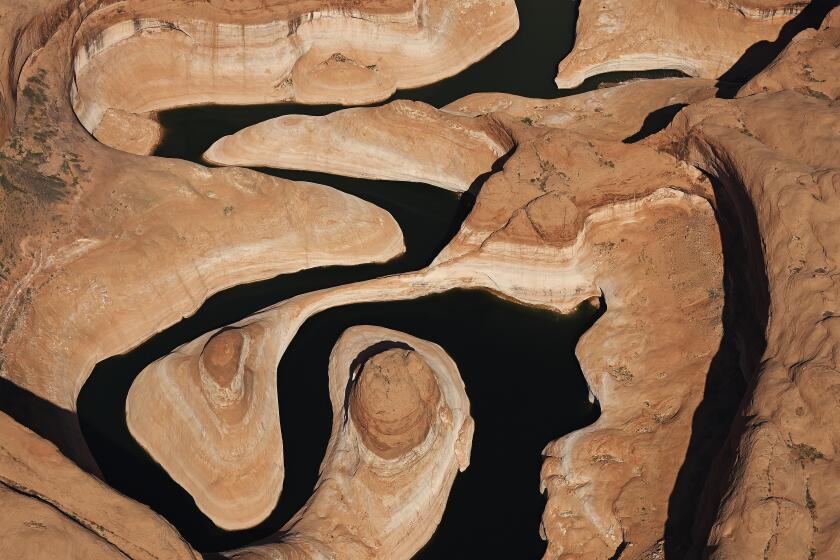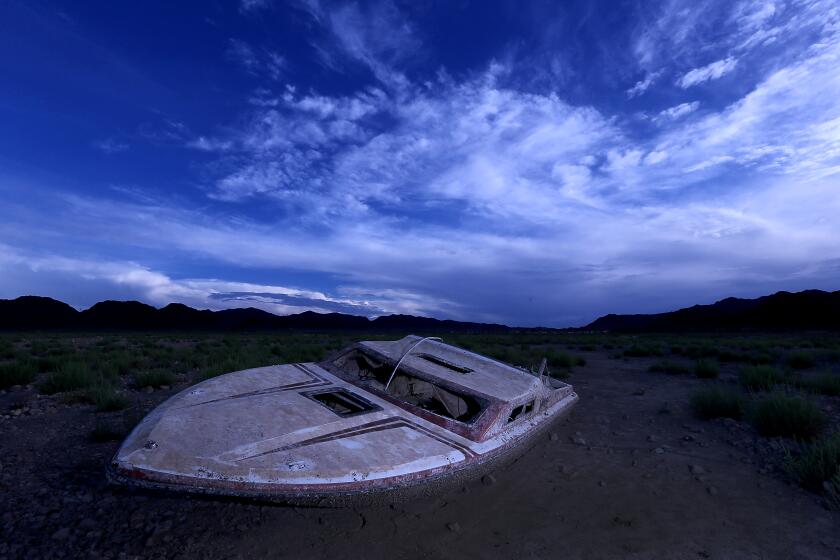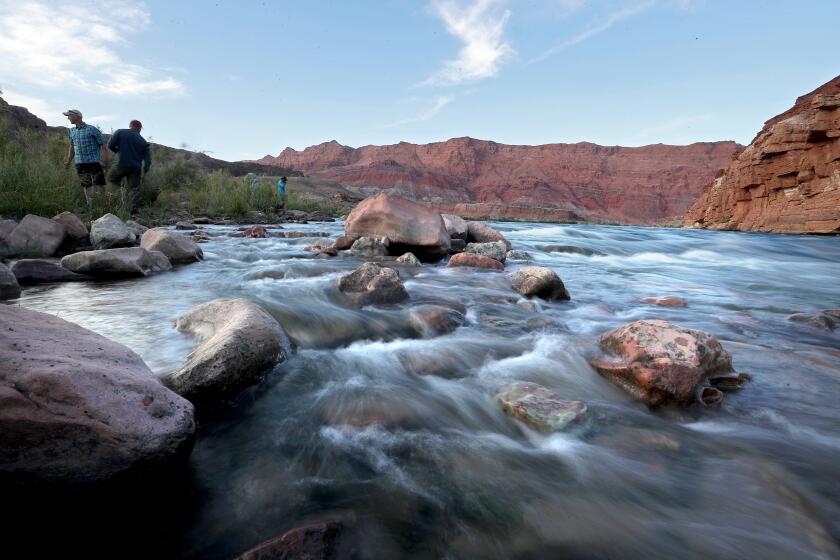Colorado River Basin ranks among the world’s most water-stressed regions, analysis finds

A research effort tracking water scarcity around the world shows California, Arizona and other Western states are experiencing water stress at high levels similar to arid countries such as Saudi Arabia and Qatar.
The analysis by researchers with the World Resources Institute found that all seven states that rely on the Colorado River face high or extremely high water stress. Arizona ranked first for the most severe water stress in the country, followed by New Mexico and Colorado, while California ranked fifth.
“When I put the results on a map, the first thing I saw was the Colorado River Basin,” said Samantha Kuzma, the nonprofit group’s data lead for the assessment, called the Aqueduct Water Risk Atlas.
The analysis found that 25 countries, with about one-fourth of the world’s population, are exposed to extremely high water stress. Those countries include Bahrain, Cyprus, Lebanon, Israel, Chile, Jordan, Greece and Tunisia, among others.
The United States as a whole doesn’t meet the threshold to be considered a country with high water stress.
“But if you were only to count the Colorado River Basin, it would be one of the most water-stressed countries in the world,” Kuzma said. “It ranks at the top of the list with the other extremely high countries.”
The analysis was released after the federal government announced Tuesday that a snowy winter and rising reservoir levels had slightly eased the severity of the water shortage on the Colorado River, an improvement that will mean smaller reductions in water deliveries next year for Arizona, Nevada and Mexico.
But the analysis highlights warnings from experts who say that even though the Colorado River has benefited from one of the wettest winters in years, the long-term gap between heavy demands and limited supply will require significant reductions in water use.
Lake Mead and Lake Powell, the two largest reservoirs in the country, remain at historically low levels. Even with the rise in water levels this year, the reservoirs are at 36% of capacity.
“The problem on the Colorado River does not get erased with one wet year. And in fact, climate change pretty well ensures that this problem continues,” said Jennifer Pitt, director of the National Audubon Society’s Colorado River program. “While there is a temporary reprieve, and while there will always be wet years and dry years, the overall trend is warmer, drier, and less water availability.”
Seven states have agreed to cut water use to boost the Colorado River’s depleted reservoirs, reaching a consensus after months of negotiations.
In assessing water-stressed regions globally, the World Resources Institute’s team worked with researchers at Utrecht University in the Netherlands to examine long-term trends in water demand and supply using various data sources and a global hydrologic model. They defined countries and regions facing extremely high water stress as those using most of the water they have — more than 80% of their renewable supply every year.
The researchers said their large-scale comparison shows that the world’s most water-stressed regions include the Middle East and North Africa, followed by South Asia. They also analyzed how global warming is making water scarcity worse.
They found that about 4 billion people, or half the world’s population, are exposed to extremely high water stress at least some of the time, and that by 2050 that number could reach nearly 60% of the global population. They also examined how water stress threatens economies, and estimated that about one-third of global gross domestic product may be “exposed to high water stress” by 2050.
“There is a lot to be concerned about. Our ability to manage this water stress in the future won’t be as easy as it’s been in the past,” Kuzma said.
The researchers considered long-term trends based on data from 1979 to 2019. Even though California has benefited from heavy snow and rain this year, the researchers found the state is under high water stress based on long-term trends.
The analysis doesn’t consider how states or regions are taking steps to address water stress using infrastructure, such as transporting water from other regions through canals and tunnels, as California and Arizona do. The analysis also doesn’t fully account for overpumping of groundwater, a widespread problem in much of the American West and many of the world’s food-producing regions.
The data may offer a large-scale look at parts of the world with limited water supplies, but its usefulness is limited because it seems to overestimate risks in some regions and underestimate risks in others, said John Matthews, executive director of the Alliance for Global Water Adaptation.
Looking at the water-stressed zones that researchers mapped in red around the world, Matthews said, “it feels to me like a very alarming diagnosis with kind of no sense of what the treatment options are.”
He said he’s concerned that the way the data are presented might discourage investments in parts of the world that are highly water stressed, such as Mexico, where more investment is needed.
The United Nations held its first water conference in decades, focusing on crises and solutions. The U.N. chief said ‘water is in deep trouble’ globally.
In the Colorado River Basin, Matthews said, the data are simply “validating truths already self-evident.”
“Those states have difficult choices to make, and I think they already knew that. These are states that have work to do,” Matthews said.
The Colorado River has long been overallocated, and its reservoirs have declined during severely dry years since 2000. In one recent study, scientists estimated that the river’s flow has decreased 10.3% because of higher temperatures, and these declines are projected to worsen as warming driven by the burning of fossil fuels continues to dry out the watershed.
During its annual announcement of reservoir operation plans Tuesday, the Bureau of Reclamation said that in 2024, Lake Mead will be in a Level 1 shortage, a step down from a Level 2 shortage, which under shortage-sharing agreements means slightly smaller reductions for Arizona and Nevada than those states saw in 2023.
Mexico is also participating in reductions under an agreement with the U.S.
Beyond those agreed-to reductions, the seven states have proposed plans to cut water use further over the next three years. The federal government in June also initiated negotiations on long-term plans for dealing with shortages after 2026, when the existing interim rules expire.
The federal government is opening negotiations on long-term plans for the Colorado River. Leaders of tribes say they don’t want to be left out of key talks.
Recent discussions among the region’s water management officials have focused largely on efforts to reduce water use with support from $1.2 billion in federal funds made available through the Inflation Reduction Act. Interior Department officials have said much of the reductions in water use will come by paying agricultural landowners, water districts and others to conserve water, helping to reduce the pressures on the limited supply in Lake Mead.
The Bureau of Reclamation said this year’s water releases from Lake Mead at Hoover Dam are projected to be the lowest in 30 years, reflecting conservation efforts supported by federal funds as well as other factors.
The Southwest needs a range of solutions to reduce water use in the coming years, Matthews said, including improving efficiency, recycling and reusing water, and reducing the amounts used for water-intensive crops like alfalfa, as well as for thirsty lawns in cities and suburbs.
“We really need to be thinking about a lot of really large-scale changes,” Matthews said.
The researchers at the World Resources Institute said the latest update of the data, called Aqueduct 4.0, is designed for comparing regions on a large scale as a “prioritization tool,” and that local assessments are also needed.
The researchers said improving water management is vital for adapting to the effects of climate change and feeding the world’s growing population. They recommended solutions such as increasing water efficiency in agriculture by installing water-saving irrigation systems, recycling wastewater and embracing nature-based solutions by protecting and restoring forests and wetlands, among other things.
“The issues we have with water are solvable,” Kuzma said. “And we have a lot of the solutions that we need to address them. We just are lacking the political will to actually do something about it.”














